

Ficus ginseng is a bonsai-like houseplant. Great for beginners, it’s got a thick root trunk and very nice leaves.
Key Ficus Ginseng facts
Name – Ficus ‘ginseng’
Scientific – Ficus microcarpa
Family – Moraceae (mulberry family)
Type – indoor plant
Height – 8 to 40 inches (20 to 100 cm), up to you
Foliage: evergreen – Difficulty: easy – Watering: moderate
Exposure: lots of indirect light – Soil: indoor plant mix, well drained
Stems grow directly from the large root, producing an amazing effect. It is easy to care for, and here is how to water and prune it – and when to repot it.
Although it is easy to care for, Ficus ginseng does require a little care. Watering, fertilizer and pruning give it all the chances it needs to live for decades.
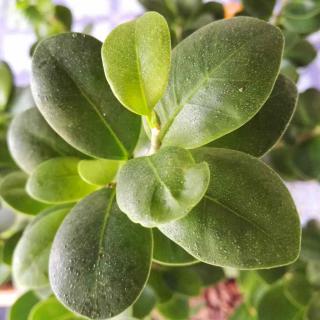 Ficus ginseng appreciates warmth. That’s why indoor living suits it well: temperatures range from 60 to 75°F (15 to 25°C).
Ficus ginseng appreciates warmth. That’s why indoor living suits it well: temperatures range from 60 to 75°F (15 to 25°C).Ficus ginseng rarely ever bear flowers and fruits. In exceptional cases, if conditions are perfect, it might happen: you’ll get a tiny fig!
Ficus ginseng doesn’t require abundant watering. Don’t water a lot, and don’t water too often.
 Water the ficus only when the surface of the soil is really dry. Test it with your finger.
Water the ficus only when the surface of the soil is really dry. Test it with your finger.Your ficus ginseng will appreciate having its leaves cleaned often with a rag or a moist paper towel.
Ficus ginseng loves it when air moisture is high.
When you water, you can also provide fertilizer.
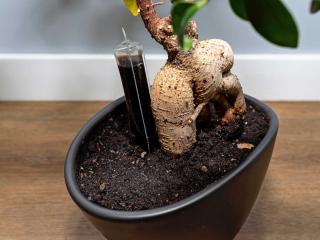
What matters is that it’s balanced, meaning the “N-P-K” numbers are identical or close. If different, favor a mix with more nitrogen (N) and less phosphorus/potassium (P/K).
If you consider your Ficus ginseng to be a bonsai, and that you want to keep its shape small, you’ll have to prune it regularly.
Snip new shoots off as they appear for the original shape to be preserved. Or, make it evolve to the shape you wish it to take.
Sometimes the Ficus ginseng comes with small branches grafted on a larger root.
Not only would the ficus change shape, grafted branches will be deprived of sap and die off. Grafted branches are small-leaved, and the root stock is a large-leaf variety.
It might be that your Ficus ginseng is simply watered too much, that it lacks surrounding moisture or light, or that it is set in a place full of drafts.
This is often caused by red spider mite.
This is usually due to mealybugs or scale insects to which the Ficus ginseng is very vulnerable, especially indoors.
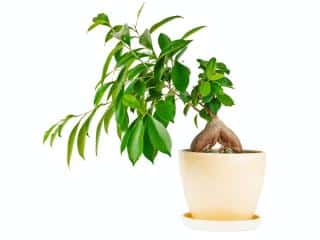
Sometimes larger leaves appear because growth inhibitors had been sprayed on the plant while at the nursery. Growth inhibitors slow growth and reduce the size of leaves. When it wears off, leaves take on their natural size.
It doesn’t bear any leaves, starts off as a light-colored shoot but bark gradually appears.
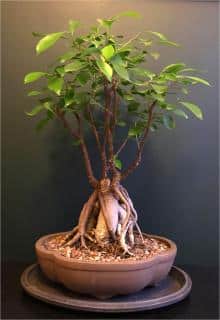
Its small size and thick trunk make it a very decorative plant, ideal for modern designer homes. It also clears air pollution.
The word “ginseng” means root in Chinese, and is attributed to this plant because of the magnificent aerial root. However, its very shiny dark green leaves are equally appealing.
Since it is easy to grow and care for, it is often called the beginner’s bonsai. Its life cycle can span many years, even decades, and the key to a successful life is simply to provide appropriate watering.
Ficus ‘ginseng’ is the common name for what is usually called Ficus microcarpa in the scientific community. The name “ginseng” refers to the appearance of the root. Actually the thick, bulbous stem was an underground part of the plant, dug out and planted about 4 inches (10 cm) above ground level.
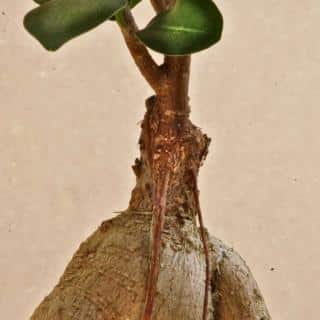
95% of all Ficus ginseng plants sold are actually Ficus microcarpa grafted together with other varieties like Ficus benjamina, Ficus retusa, and lesser-known cultivars filling in the rest.
Other plants bear a confusing resemblance to Ficus ginseng, too!
Ficus ginseng is different from Panax ginseng, the “original” ginseng root used for its health benefits.
When only few leaves are visible, Ficus ginseng is easily confused with another thick-stemmed plant, Adenium obesum. Telling them apart is easier when Adenium blooms.
Read also:
Ficus ginseng will appreciate spending the winter in a cooler spot, ideally around 60°F (15°C).
Hello, I have just stumbled upon your site, started looking up orchids 😏 which went through far too many tangents haha and then, happily, happened upon this wonderful article of yours after I glanced at my poor one. I am a trial and error type of gardener ( if you say that about houseplants? Hehe) and most of the time I get it right eventually. I’ve lost a few things unfortunately but I just love all plants and flowers 💐 ☺️❤️ I’m limited to a couple of places for indoor ones because of conditions of course and indoor cats who are obsessed with them too, but for dinner 🙃 🐈⬛ 🍽
Sorry if this is far too long or not appropriate for this section or anything 🙏 but the reason for the comment is really to thank you for this article. The way it’s set out and the links and everything about it really, are very reader friendly, unpretentious and I have learnt a lot 🫶 I’m worried I might have done irreparable damage to mine 😭 but I feel like now I have a much better chance of seeing her back to her full beauty again hehe
Thank you very much for taking the time to read this essay 😆 and I really do appreciate all of the information 🙏 very helpful and I look forward to perusing the rest of your site 😊 and I will recommend you 🫶💐❤️ I know 2 definite future members before even asking haha, have a great weekend 🚀
Hi etak, that was a very generous essay you shared with us there! I’m very happy you found the article interesting and well-linked. It’s a big job to always change the articles and increase their quality. So it’s a real treat when someone is grateful and says so! Thank you in return! ❤️❤️❤️
There was a question in your essay, I transferred it directly to the forum so I and others can respond. It’s right here: when to repot my ficus ginseng. Meet you there to answer it!
Thanks for the article, great info! I’m trying to identify my Ficus bonsai which until recently I thought was a Money Tree. It looks identical to the one pictured, although the leaves are pointed ovals, not rounded at the tip. It was not doing well until I recently fertilized, now it’s responding great and finally growing new leaves for the first time in about a year. It’s been through a few cat attacks (chewing on the leaves) and a few overwaterings which caused major leaf drop. I usually keep it on the drier side, forgetting to water it but I’m trying to take better care of it now and get it into better shape. I’d love some help identifying which variety it is.
Hi Julie! Great to hear you’re getting the hang of things. It’s nice that this particular type of Ficus is rather forgiving, it makes for excellent practice for other plants. There’s a chance it may be a Ficus retusa – I just added a new picture with a close-up of leaves of that species on its article for you. You’ll see the leaves are more pointy than those of Ficus microcarpa, which is normally used for Ficus ginseng bonsai-like specimens. Actually, the name “Ficus ginseng” isn’t really a botanical or scientific name for the species, since the real plant is Ficus microcarpa. It’s more of a commercial name, used to describe the plant you get when you try to make a bonsai out of a random Ficus species (or combination thereof in case of grafted ones).
“Money tree” is usually the common name of the pachira plant, which itself is very similar to Schefflera… and the fact that there’s even a “Ficus Treasure” plant makes things pretty complicated indeed!
Hello,
I inherited a plant someone was going to throw away last year and still haven’t decided what it could possibly be? I have recently decided to replant it into a larger pot because it had been in this tiny ridiculously small wood type container with moss on the top. It had mold in it so I decided to just put it in new Cactus soil because I knew that was well-draining. It seems to be doing okay but hasn’t grown very much in the last year. It seems like it’s not exactly happy but surviving. It does not like to be in water and does well if it dries out for some time in between waterings. Right now I have it in a double-walled self-watering ceramic container that does not have glaze on the part where the plant sets.
Mostly I’m just curious if there is anyone who can help me identify this poor little plant? I just want to be able to take great care of it and make it comfortable. The little container that it originally came in (I believe) had a barcode on the bottom so I don’t believe it is anything highly exotic.
Thank you!
Dara
Sure thing! I just responded to the email you sent me. The plant you thought might be a Ficus ginseng actually turned out to be an Adenium obesa. Also quite a nice plant for bonsai-like pots!
Thank you so very much!
I read up on it and potted it again in a pot with holes this time and put it closer to some natural light in my kitchen.
I cannot thank you enough! I am going to take very good care of this little guy and will send pictures when he blooms! You are too kind!!
Dara
Thank you so much for the fast and detail feedback. I think I’m going to do this when I come back from a 2 week vocation in Ontario & Quebec.
Hope it won’t get too cold for the plant when I come back. I have to leave it on the apartment balcony for the 2 weeks, it will not be much air circulation inside when I shut the glass doors.
Sure thing, Bryan! It should be ok. All the best!
Which is the best season to repot it? Should I prune it heavily during repot? It’s been over 2 years since I transfered my Ginseng Ficus to a bigger pot. I’m living in Richmond BC Canada, temperature by now is around 15-20C outside my balcony, it’s Autumn.
Hello Bryan, thanks for your question. Here are a few pointers to answer you:
You’re right on schedule for this step! To help out, I’ve expanded the article a bit on the section about how to repot a ficus bonsai, it can serve as a guideline for you.
Hope this helps!